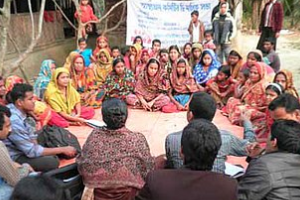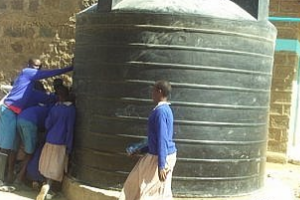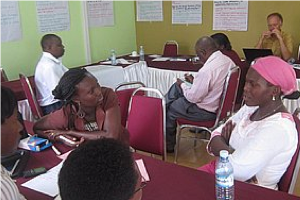Difference between revisions of "Monitoring"
(→Field experiences) |
(→Other links) |
||
| (10 intermediate revisions by the same user not shown) | |||
| Line 46: | Line 46: | ||
The following projects are making use of Monitoring methods: | The following projects are making use of Monitoring methods: | ||
| − | {|style="border: 2px solid # | + | {|style="border: 2px solid #e0e0e0; width: 60%; text-align: justify; background-color: #e9f5fd;" cellpadding="2" |
| + | |- style="vertical-align: top" | ||
| + | |[[Image:akvorsr logo_lite.png|center|60px|link=http://akvo.org/products/rsr/]] | ||
| + | | <!--place holder--> | ||
| + | |[[Image:akvorsr logo_lite.png|center|60px|link=http://akvo.org/products/rsr/]] | ||
| + | <!--RSR table begins--> | ||
|- style="vertical-align: bottom" | |- style="vertical-align: bottom" | ||
|[[Image:project 475.png|thumb|center|140px|<font size="2"><center>[http://rsr.akvo.org//project/475/ RSR Project 475]<br>Health Village: WASH Monitoring Perspective</center></font>|link=http://rsr.akvo.org//project/475/]] | |[[Image:project 475.png|thumb|center|140px|<font size="2"><center>[http://rsr.akvo.org//project/475/ RSR Project 475]<br>Health Village: WASH Monitoring Perspective</center></font>|link=http://rsr.akvo.org//project/475/]] | ||
|[[Image:project 469.png|thumb|center|140px|<font size="2"><center>[http://rsr.akvo.org//project/469/ RSR Project 469]<br>Implementing an IWRM process in Mashuru</center></font>|link=http://rsr.akvo.org//project/469/]] | |[[Image:project 469.png|thumb|center|140px|<font size="2"><center>[http://rsr.akvo.org//project/469/ RSR Project 469]<br>Implementing an IWRM process in Mashuru</center></font>|link=http://rsr.akvo.org//project/469/]] | ||
|[[Image:project 487.png|thumb|center|140px|<font size="2"><center>[http://rsr.akvo.org//project/487/ RSR Project 487]<br>Knowledge Management and Learning, Uganda WA</center></font>|link=http://rsr.akvo.org//project/487/]] | |[[Image:project 487.png|thumb|center|140px|<font size="2"><center>[http://rsr.akvo.org//project/487/ RSR Project 487]<br>Knowledge Management and Learning, Uganda WA</center></font>|link=http://rsr.akvo.org//project/487/]] | ||
| − | |||
| − | |||
| − | |||
| − | |||
|} | |} | ||
=== Selected references, tools and templates === | === Selected references, tools and templates === | ||
| − | * | + | *African regional [http://www.waterservicesthatlast.org/countries/ghana_triple_s_initiative/publications_list fact sheets] on services monitoring, at bottom of page. |
| − | *[http:// | + | *[http://mwa.akvoflow.org/ Field Level Operations Watch (FLOW), also known as Akvo FLOW] |
| − | *[http://www. | + | *[http://www.waterpointmapper.org/ Water Point Mapping Tool] (Wateraid) |
=== Other links === | === Other links === | ||
| Line 69: | Line 70: | ||
*[http://www.waterservicesthatlast.org/Resources/Presentations/Triple-S-Research-Seminar-September-2012-Kampala-Uganda/Water-service-delivery-indicators Water service delivery indicators: presentation] | *[http://www.waterservicesthatlast.org/Resources/Presentations/Triple-S-Research-Seminar-September-2012-Kampala-Uganda/Water-service-delivery-indicators Water service delivery indicators: presentation] | ||
| − | *[ | + | *[https://thewaterproject.org/monitoring-and-evaluation Water for People: Monitoring and evaluation] |
| − | *[http://www. | + | *[http://www.wsportal.org/ Water Safety Portal] |
| − | |||
| − | |||
*[http://docs.watsan.net/Downloaded_Files/PDF/UNICEF-2011-WASH.pdf UNICEF: WASH in schools monitoring package] | *[http://docs.watsan.net/Downloaded_Files/PDF/UNICEF-2011-WASH.pdf UNICEF: WASH in schools monitoring package] | ||
| Line 89: | Line 88: | ||
*[http://docs.watsan.net/Downloaded_Files/PDF/Berkowitz-2009-Water.pdf Centre for Applied Legal Studies/ The Mvula Trust: Water budget monitoring education tool] | *[http://docs.watsan.net/Downloaded_Files/PDF/Berkowitz-2009-Water.pdf Centre for Applied Legal Studies/ The Mvula Trust: Water budget monitoring education tool] | ||
| − | *[http:// | + | *[http://wedc.lboro.ac.uk/resources/conference/34/Fogelberg_K_-_191.pdf WEDC Conference: Looking forward and backward: Implementing global mapping and monitoring tools: The case of the Honduras] |
| − | *[http:// | + | *[http://wedc.lboro.ac.uk/resources/conference/34/Godfrey_S_-_719.pdf WEDC Conference: Sustainability check - A monitoring tool for the sustainability of rural water supplies] |
| − | *[http:// | + | *[http://fontes.no/foundation/portfolio/sustainability-of-rural-water-supplies-through-monitoring/ WEDC Conference: Sustainability of rural water supplies through monitoring] |
| − | *[http:// | + | *[http://wedc.lboro.ac.uk/resources/conference/34/Koestler_M_A_-_126.pdf WEDC Conference: Live monitoring of rural drinking water schemes using mobile phone infrastructure] |
| − | *[http:// | + | *[http://wedc.lboro.ac.uk/resources/conference/34/Sarkodie_Y_A_-_374.pdf WEDC Conference: Making use of available water and sanitation data through independent monitoring programmes] |
| − | *[ | + | *[https://www.eawag.ch/fileadmin/Domain1/Abteilungen/sandec/publikationen/WST/Johnston_Halder_2009.pdf WEDC Conference: Monitoring impacts of WASH interventions: The case of SHEWAB] |
| − | *[http:// | + | *[http://legacy.ewb.ca/en/whatwedo/overseas/projects/watsanmalawi.html EWB- Canada: Water Access in Malawi] |
===Acknowledgements=== | ===Acknowledgements=== | ||
* [http://www.waterservicesthatlast.org/resources/building_blocks/monitoring Monitoring]. Water Services That Last. IRC. | * [http://www.waterservicesthatlast.org/resources/building_blocks/monitoring Monitoring]. Water Services That Last. IRC. | ||
| − | : [[File:IRC logo.png|left|60px|alt=IRC | + | : [[File:IRC new logo.png|left|60px|alt=IRC |link=http://www.irc.nl/]] |
| − | |||
| − | |||
Latest revision as of 03:25, 8 June 2016

monitoring in Latin America
in South Sudan
service delivery symposium - day 2
using mobile phones
Monitoring systems track indicators of infrastructure functionality, service provider performance, and levels of service delivered against nationally agreed norms and standards.
Regular collection, collation, and analysis of reliable data are crucial building blocks in delivering sustainable services. Monitoring systems should track not only access, but the quality of a service over time, as well as performance of operators in key technical, financial, and management functions.
Contents
Why is it important for sustainable services at scale?
Basic monitoring data is critical for performance management and to enable local operators to assess problems, anticipate and address them, before the quality of service starts to deteriorate.
Setting explicit targets for the levels of service in addition to coverage also helps countries to focus their efforts to improve service delivery, measure progress and take corrective actions in an informed and targeted way at sector level.
Monitoring strategies can naturally link with water safety plans which go beyond traditional measuring of water quality and include the entire drinking-water supply chain, involving risk assessment and management. With the impact of climate change this will become increasingly more important.
Dimensions of monitoring
- Level of service: to monitor a service, there first needs to be agreement on the service level (e.g. 25 litres per person per day). A service ladder provides a way to conceptualise different and increasingly higher levels of service. Monitoring typically then assess key parameters of quality, quantity, reliability and accessibility.
- Service providers: these can be community committees or public or private sector operators. Monitoring helps to improve services by highlighting weaknesses and improving their performance in key areas such as financial and technical management.
- Service Authorities: service authority functions are typically carried out by local government and include establishing and enforcing by-laws, planning at the local level for infrastructure, letting of contracts for construction and providing oversight and back-up support to service providers. Monitoring these functions helps to reinforce their importance.
Costs and technology
Conventional monitoring methods with pen and paper are slow and prone to entry errors. New technologies can make collection and mapping of data faster and more accurate. For example: the mapping tool launched by WaterAid; or the monitoring and reporting tool of Field Level Operations Watch (FLOW). A number of similar systems are being piloted at scale and show promise in making monitoring cheaper and more reliable.
The costs of monitoring are difficult to isolate. Recent research suggests a range from a few US cents to $0.5 per person per year for data collection. Budgets must be made available to carry out monitoring on a regular basis, if data collection is to be reliable and leads to improved performance management at different levels.
Recommendations
- Adapt indicators to focus on the level of service provided and define sector targets
- Introduce basic indicators to monitor service providers to help improve performance and to take corrective action
- Introduce basic indicators to monitor service authority functions
- Improve alignment around monitoring to ensure adherence to minimum requirement
- Data collection is only worthwhile when subsequent steps are taken to analyse the data and feed the resulting information into decision-making processes.
Field experiences
The following projects are making use of Monitoring methods:
 Health Village: WASH Monitoring Perspective |
 Implementing an IWRM process in Mashuru |
 Knowledge Management and Learning, Uganda WA |
Selected references, tools and templates
- African regional fact sheets on services monitoring, at bottom of page.
- Water Point Mapping Tool (Wateraid)
Other links
Acknowledgements
- Monitoring. Water Services That Last. IRC.
